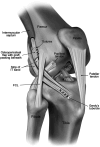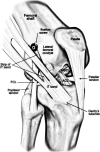Approach to Residual Anterolateral Rotatory Knee Instability After Anterior Cruciate Ligament Reconstruction
- PMID: 40487140
- PMCID: PMC12136665
- DOI: 10.2106/JBJS.OA.25.00002
Approach to Residual Anterolateral Rotatory Knee Instability After Anterior Cruciate Ligament Reconstruction
Abstract
» Arthroscopic anterior cruciate ligament (ACL) reconstruction is widely regarded for its excellent results in restoring tibiofemoral anterior laxity to near-normal levels.» However, some operated patients may still experience anterolateral rotatory instability, leading to dissatisfaction and feelings of instability. After ruling out injuries to the posteromedial corner, lateral collateral ligament, and posterolateral corner, the focus should shift to the anterolateral ligament (ALL) and Kaplan fibers.» For ALL injuries causing internal rotatory instability at around 30 degrees knee flexion, a modified deep Lemaire tenodesis is recommended.» Kaplan fiber injuries leading to internal rotatory instability at angles greater than 30 degrees knee flexion can be treated with a modified superficial Lemaire surgery and iliotibial band strap fixation in the distal Kaplan fiber anatomical position.
Copyright © 2025 The Authors. Published by The Journal of Bone and Joint Surgery, Incorporated. All rights reserved.
Conflict of interest statement
The authors declare that there is no conflict of interest that could be perceived as prejudicing the impartiality of the research reported. All co-authors have agreed with the final manuscript's contents, and no financial interest remains to be announced. Disclosure: The Disclosure of Potential Conflicts of Interest forms are provided with the online version of the article (http://links.lww.com/JBJSOA/A816).
Figures










Similar articles
-
Anterolateral Knee Extra-articular Stabilizers: A Robotic Study Comparing Anterolateral Ligament Reconstruction and Modified Lemaire Lateral Extra-articular Tenodesis.Am J Sports Med. 2018 Mar;46(3):607-616. doi: 10.1177/0363546517745268. Epub 2017 Dec 21. Am J Sports Med. 2018. PMID: 29268024
-
Anterolateral Tenodesis or Anterolateral Ligament Complex Reconstruction: Effect of Flexion Angle at Graft Fixation When Combined With ACL Reconstruction.Am J Sports Med. 2017 Nov;45(13):3089-3097. doi: 10.1177/0363546517724422. Epub 2017 Sep 12. Am J Sports Med. 2017. PMID: 28898106
-
Biomechanical Comparison of Anterolateral Procedures Combined With Anterior Cruciate Ligament Reconstruction.Am J Sports Med. 2017 Feb;45(2):347-354. doi: 10.1177/0363546516681555. Epub 2016 Dec 27. Am J Sports Med. 2017. PMID: 28027653
-
[Anterolateral stabilization using the modified Lemaire technique for ACL deficiency].Oper Orthop Traumatol. 2019 Feb;31(1):36-44. doi: 10.1007/s00064-018-0579-z. Epub 2018 Nov 26. Oper Orthop Traumatol. 2019. PMID: 30478634 Review. German.
-
Anterior Cruciate Ligament Injury and the Anterolateral Complex of the Knee-Importance in Rotatory Knee Instability?Curr Rev Musculoskelet Med. 2019 Dec;12(4):472-478. doi: 10.1007/s12178-019-09587-x. Curr Rev Musculoskelet Med. 2019. PMID: 31773476 Free PMC article. Review.
References
-
- Halewood C, Amis AA. Clinically relevant biomechanics of the knee capsule and ligaments. Knee Surg Sports Traumatol Arthrosc. 2015;23(10):2789-96. - PubMed
-
- Grassi A, Nitri M, Moulton S, Marcheggiani Muccioli GM, Bondi A, Romagnoli M, Zaffagnini S. Does the type of graft affect the outcome of revision anterior cruciate ligament reconstruction?: a meta-analysis of 32 studies. Bone Joint J. 2017;99-B(6):714-23. - PubMed
-
- Grassi A, Zicaro JP, Costa-Paz M, Samuelsson K, Wilson A, Zaffagnini S, Condello V, ESSKA Arthroscopy Committee. Good mid-term outcomes and low rates of residual rotatory laxity, complications and failures after revision anterior cruciate ligament reconstruction (ACL) and lateral extra-articular tenodesis (LET). Knee Surg Sports Traumatol Arthrosc. 2020;28(2):418-31. - PubMed
Publication types
LinkOut - more resources
Full Text Sources
